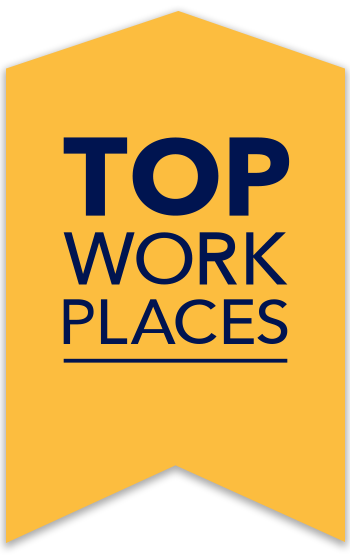Your organization’s success depends on finding and hiring the right talent to grow your business. And that starts with an effective recruitment process. After all, hiring the wrong employees costs your organization valuable time and money.
According to the Society of Human Resource Management (SHRM), the average time to fill an open job position is 36 days. Done right, an effective employee recruitment process reduces this time, streamlines the hiring process, improves the employee experience, and strengthens your employer brand. It also gives your company a strategic advantage in a competitive market.
Here are 12 ideas for improving the recruitment process you can implement starting today.
1. Start with a Great Careers Page
Your company’s careers page is the first place candidates visit when they’re considering a position. This is their first glimpse at what it might be like to work for your company, and it sets the tone for the employee experience.
Your careers page is an opportunity to showcase your culture, illustrate what sets your company apart, and differentiate your employer brand. Putting effort into a robust careers page is essential. LinkedIn reports that 59 percent of job candidates visit your site when they see a position of interest.
2. Revisit Your Job Descriptions
One of the keys to hiring the right talent is a thorough and well-balanced job description. Including the details about what a position entails is essential, of course. But adding outcome-based elements helps candidates understand the purpose of the role, the value they will contribute, and a path for growth. All of this is important to attracting new talent.
A well-written job description is also a tool you can use to improve employee retention. When a job isn’t the right fit for newly hired employees, you may find yourself going through the hiring process yet again. One study found that one-third of new hires left their jobs after only six months.
Here are some of the ways to write an effective job description:
- Choose a straightforward title and summary: Avoid obscure and overly creative titles. Be clear, accurate, and concise. Choose language that aligns with your culture and brand.
- Be transparent about qualifications and responsibilities: Be descriptive but limit the details to what is most critical to know about the job. Include a “nice-to-have” section to highlight anything that would set candidates apart.
- Diversity, equity, and inclusion: Don’t risk losing qualified candidates with biased references. If your company actively supports diversity in the workplace, promote it.
3. Streamline the Application & Interview Process
A streamlined application process makes it easier on recruiting teams and helps attract and hire the right candidates. First, create a standardized template for individual roles. Then meet with the hiring team to discuss job-related specifics. The interview process will be more effective and efficient for everyone.
In addition, brief applications simplify the hiring process for job candidates and your team. Brainstorm pre-employment screening services — such as background checks — that best suit your company.
Don’t forget using artificial intelligence in recruitment is a great way to stay streamlined.
4. Consider Additional Candidate Sources
No matter how compelling your careers page is, you need to consider other sources for your talent pipeline. A multi-channel approach that includes social media, job boards, and more will expand your reach and attract candidates more quickly and easily.
Be active on social media platforms such as LinkedIn, Twitter, Reddit, and relevant Facebook groups. LinkedIn is an excellent platform for identifying candidates that fit your needs. The growth of these channels – particularly LinkedIn – is an active and primary source for job searches.
Learn more: Inbound Recruitment and Social Media Recruitment
5. Use Candidate Assessments
Assessments are another way to learn about candidates and find the right match for your organization. These assessments can range from general skills to real-world example assessments. Choose from a variety of online assessments, or you can create something unique to the specific job role you are trying to fill. Assessments are also helpful in identifying candidates who may have overstated their qualifications on the job application.
6. Involve Employees in Interviews
Including current employees in the hiring process, such as panel interviews, is helpful too. In addition to supporting your hiring team, employee involvement enables deeper conversations and provides candidates with a glimpse of what it’s like to work for your organization.
Group interviews create an interview structure that incorporates multiple points of view. In addition to offering a broad range of perspectives, this approach makes your current employees feel more valued and included.
7. Continued Communication with Candidates
After applying, there may be a waiting period before candidates will hear from your company. Keep candidates engaged and in the loop during this time. Create calendar reminders or use an application to ensure continuous communication and a sense of connection.
Providing candidates with updates will help to retain their interest in the position and your company. Being transparent about your interest in a candidate can go a long way.
8. Ask for Employee Referrals
Employee referrals are one of the most powerful ways to improve the recruitment process. Implement an employee referral program to expand your reach and involve employees in the process. Engaged employees already familiar with your company – and are willing to refer their networks to you – are an excellent way to find the best fit for your company.
Communicate with employees about open job postings and encourage them to refer potential candidates. Employee referrals provide another path to qualified candidates and decrease the time spent looking for candidates using traditional methods.
According to LinkedIn, 45 percent of employees sourced from employee referrals stay more than four years. In comparison, only 25 percent of employees sourced through job boards remain for two years or more.
Employee referrals are one of the top sources for recruiting new hires. One study shows they are 5x more effective when compared to the average percentage across all sources.
Engaged employees refer your company to others. Energage research shows that 80 percent of employees at Top Workplaces will recruit their networks and friends for you. This number remained high even during the Covid pandemic.
9. Consider the Benefits Important to Employees
Leverage the benefits that make your company stand out from the competition. Use those that set your company apart – such as remote working, monetary incentives, and flex time – to attract candidates. Showcasing and promoting what makes a company a great place to work outside of financial benefits is a great way to get candidates excited about the organization.
10. Consider Internal Candidates
A practical but sometimes overlooked way to find qualified candidates is to look within your organization. Your employees are already familiar with your company values and culture, and they know what is expected of them. Internal candidates reduce the time required for onboarding. This illustrates that you support their advancement and that there are opportunities for growth within your organization.
11. Survey Candidates About the Hiring Process
Whether or not a candidate is offered a position, getting feedback from job applicants provides insightful data. This indicates to candidates that you care about their experience and identifies where there are opportunities for improvement. In addition to improving the process, it shows candidates that you care about their input on how the process went. Candidates chosen for a position are likely to provide positive feedback about the hiring process. That’s why it’s essential to also collect and review feedback from those not hired. Their input will identify where there are opportunities to improve your recruitment efforts.
Some sample questions to consider include:
- How would you rate your experience with the interview process?
- Would you recommend to others applying to this company?
- Did you feel well-informed about the hiring process and next steps?
12. Showcase Your Employer Brand and Company Culture
Every company has a distinct and unique culture. This is what differentiates your organization from the next. And done properly, culture can also be a competitive advantage. Be intentional about building a people-first culture that attracts and retains talent.
Building a strong, authentic, and credible employer brand is the best way to communicate your culture. Candidates want to know that their company has a solid set of values and core beliefs that align with their own. Use your culture and brand to market yourselves on social media, in job listings, and across your website.
Examples of employer branding tools include:
- Employee survey data visuals that illustrate where your company excels
- Employer recognition awards such as Top Workplaces
- Employee survey comments that highlight key culture strengths
Grab job prospects’ attention by showcasing your culture, employer recognition awards, and employer branding assets on multiple channels, including your website, careers page, social media, advertising, and more.
Take the first step toward building and branding a company that attracts the right talent. Nominate your company for a Top Workplaces award.

